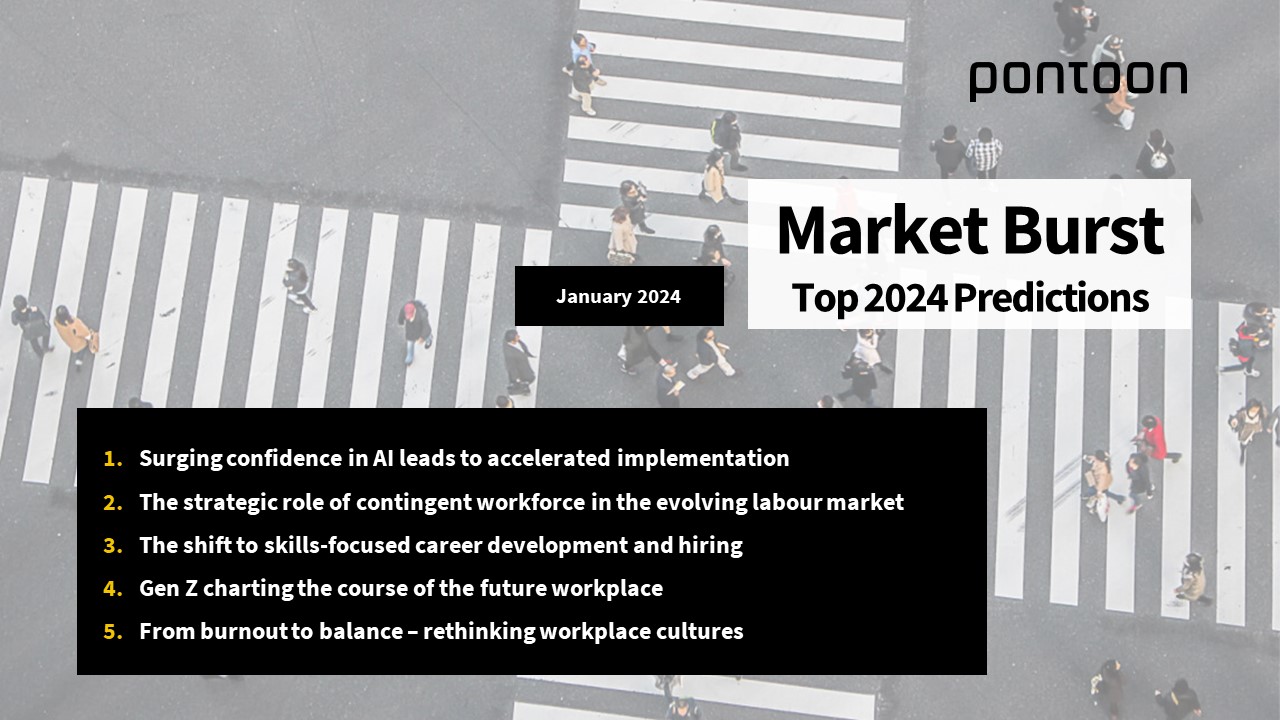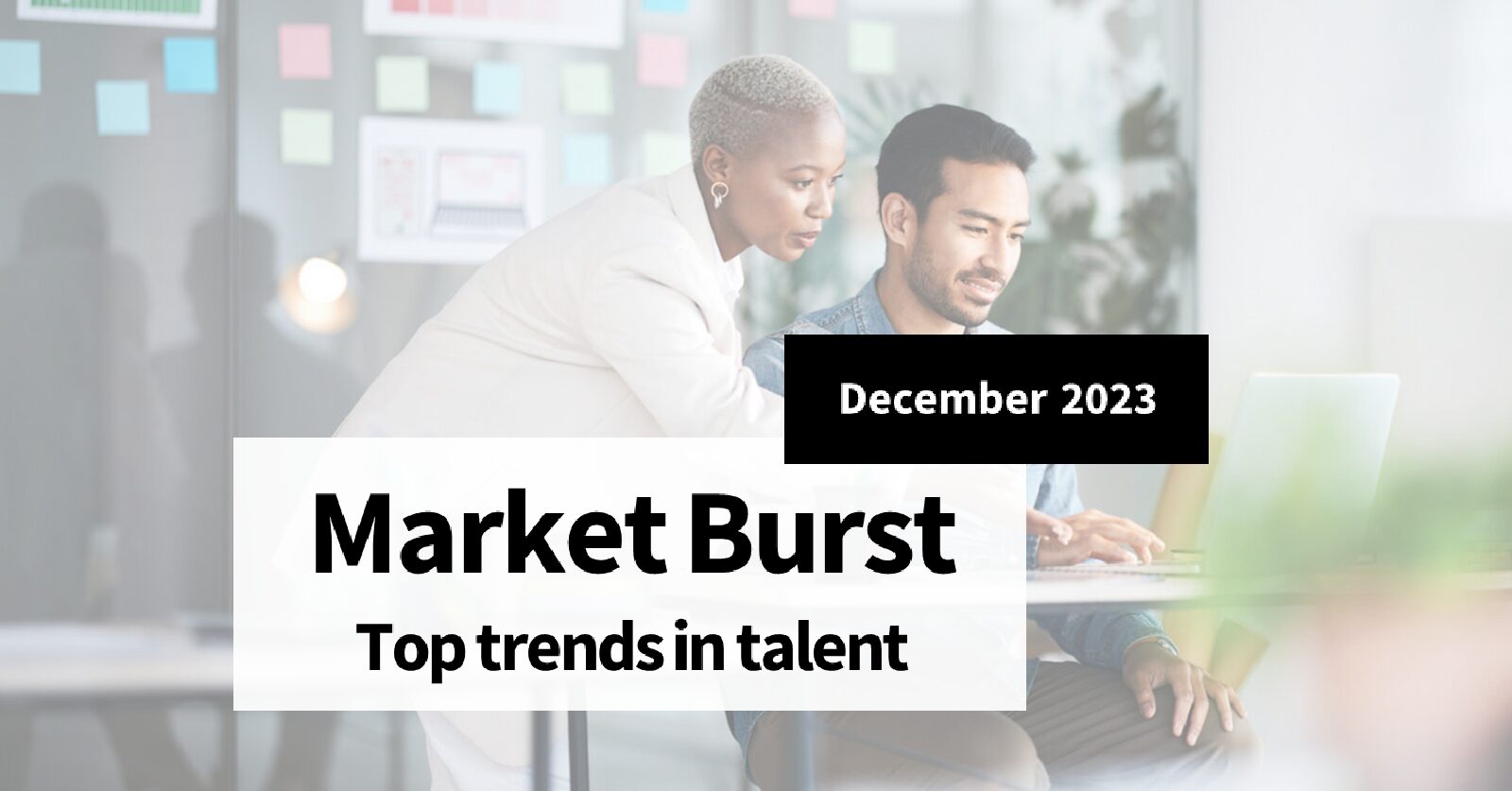Workforce predictions 2024
Research
.
Explore the top 2024 workforce predictions that will drive talent management this year. These include accelerating implementation of AI, shift to skills-focused hiring, rethinking workplace culture, and the lastest insights from our Global Workforce of the Future report.
Surging confidence in AI leads to accelerated implementation
Last year, 9 in 10 leaders admitted that their company should be using generative AI or machine learning “often” or “almost always”, but 60% said their organisation rarely or never does.
In 2024, we’ll likely see this gap close as employers and workers gain more confidence in using AI. Our Global Workforce of the Future Report shows that 6 in 10 workers believe the AI’s impact on their jobs will be positive. Most workers point to productivity gains as the top advantage, but over 50% also expect AI to help access professions that were not available to them before. This resonates across most industries, with life-sciences workers being the most optimistic.
We are past the point of asking whether firms should implement gen AI. It is becoming our daily reality, and organisations that are slow to embrace it will be left behind. Now is the time to make the most of the workers’ optimism, better understand AI’s potential to enhance working lives, and integrate the tech into everyday operations. This calls for change management, mapping new roles, and getting skilled up – fast.
The strategic role of contingent workforce in the evolving labour market
As forecasted by Staffing Industry Analysts (SIA), the significance of contingent workforce programmes is expected to increase in 2024, which doesn’t come as a surprise. Amid the swiftly evolving business and economic environment, contingent workforce solutions are crucial in helping organisations maintain agility and responsiveness to changing market dynamics. Freelancers, contractors, and gig workers can offer specialised skills, cost-effectiveness, and the capacity to scale operations easily.
By integrating non-employee workers into a comprehensive talent strategy, firms can harness the advantages of a flexible and adaptable workforce model. As this integration continues to develop, HR leaders face the challenging task of efficiently managing a contingent workforce alongside permanent staff. Currently, 64% of them point to insufficient strategic workforce planning as the main hurdle, and 43% highlight the lack of contingent workforce management skills. Pontoon’s advisory experts can help you embrace the integration of external workers into your organisation – see below for a recap of some key strategies and download our whitepaper for more details.
- Adopting a comprehensive workforce strategy that encompasses all types of workers is crucial. One hurdle might be a lack of visibility into external workforce data that is managed by procurement departments or external staffing agencies. This is where robust MSP solutions paired with powerful VMS tools can help, offering complete visibility into every step of contingent hiring, from candidate sourcing to onboarding.
- Establishing robust systems for managing, engaging, and integrating contingent workers into the company culture is also imperative. So is implementing effective communication channels, performance management processes, and a consistent onboarding experience. Hiring managers need clear guidance and well-established operating procedures to ensure consistency, transparency, and compliance in the deployment and treatment of external workers. This is where MSP experts prove invaluable.
The shift to skills-focused career development and hiring
In 2024, employers must further develop their upskilling and reskilling programmes to enable career progression opportunities within their organisations. According to our Global Workforce of the Future Report, this will be a powerful retention measure moving forward. The report shows that more workers are willing to stay with their current employer, but only if given career progression and upskilling opportunities. Unfortunately, while there has been an increase in companies focusing on their workers’ skills development, non-managers are often left behind – only 45% agree that their company invests effectively in developing their skills, compared with 74% of executives. Firms need to focus on bridging this gap to empower all workforce levels.
Most workers are confident that their skills are transferable to other industries, with 57% of white-collar workers believing their skills can be applied in other sectors vs 49% of blue-collar workers. The professional landscape is undergoing a transformation, embracing a skills-centric approach that opens job opportunities to a diverse and dynamic talent pool. Transferable competencies have become key across various roles, challenging companies to move beyond conventional hiring routes centred solely on specific job experience or educational backgrounds.
Businesses anticipate that investments in training will not only improve cross-role and cross-industry mobility but also elevate worker satisfaction and enhance productivity. Learning and Development (L&D) departments will play a crucial role in promoting people-centric organisational cultures – half of L&D professionals already collaborate more closely with executive leadership, integrating upskilling and reskilling as vital elements of their company’s overall people strategy. This trend is expected to continue.
Gen Z charting the course of the future workplace
Glassdoor reports that Gen Z is to overtake Baby Boomers in the full-time US workforce by early 2024. In fact, by 2025 Gen Zers will likely comprise more than a quarter of the global workforce.
As the entrance of Gen Z into the workforce has been anticipated, organisations are compelled to reconsider their strategies related to diversity, equity, and inclusion (DE&I), mental health, transparent leadership, and other key workplace aspects. However, it’s not only about how to bring younger generations on board; the focus is increasingly shifting towards understanding how Gen Z is actively reshaping the workplace and steering its future trajectory.
With their tech-savvy nature, Gen Zers are expected to disrupt and transform the world of work more than any previous generation. Their digital proficiency has the potential to alleviate concerns towards AI and propel its widespread adoption. Projections indicate that by 2025, 53% of Gen Zers in the US will be regular monthly users of generative AI, surpassing the figures for Gen X (35%) and Baby Boomers (16%). Young workers can spearhead initiatives to identify opportunities for AI to automate repetitive tasks, streamline workflows, and enhance overall productivity within various industries. Additionally, they can actively participate in technology adoption, using their expertise to articulate the benefits of AI tools and address any resistance from older colleagues. Given young workers’ strong emphasis on personal and professional values, they can contribute significantly to shaping ethical AI practices.
Younger generations will also propel further development of the gig economy. Embracing a forward-thinking perspective, this cohort acknowledges freelancers’ integral role in a comprehensive talent strategy. Recent surveys indicate that 6 in 10 Gen Zers perceive freelancers as a highly effective lever for constructing robust talent pipelines, compared to 47% of Millennials and 35% of Gen X. This underscores a nuanced understanding of the changing work landscape and the progressive viewpoint that Gen Z brings to workforce dynamics. Younger generations will contribute significantly to developing a flexible workforce composition – one that includes external contributors and full-time employees.
From burnout to balance – rethinking workforce wellbeing
In 2024, workers’ physical and mental health will likely continue to worsen if the root causes are not addressed. Nearly 8 in 10 large firms reported an increase in their workforce’s mental health needs in 2023, and another 16% anticipate one in the future. Employers need to focus on improving access to mental health services and consider other approaches to better support their workers’ wellbeing.
According to Pontoon’s Global Workforce of the Future Report, currently 78% of workers don’t feel supported to take time off – which means they are missing out on one of the simplest ways to prevent mental exhaustion. The report also shows that
6 in 10 workers have experienced burnout in 2023, with top reasons including working too hard and taking on more responsibilities after last year’s workforce reductions.
Companies should review their current workloads and explore internal staff movement to assist teams dealing with more tasks than the available headcount can accommodate. More than that, firms must examine their holistic corporate cultures with the intention of eliminating toxic workplace behaviours. In 2023, nearly 8 in 10 workers pointed to a healthy and sustainable work culture as most helpful to their wellbeing, followed by mental health treatment at 64% and self-care resources at 60%. It seems that while access to wellbeing professionals, apps, and courses is appreciated, most people want to operate in a healthy work environment with a manageable workload.
Related Post
Read about top trends in the world of work.
In this month’s instalment of our Market Burst, we dive into the trends that continue to drive talent management in the evolving ...





